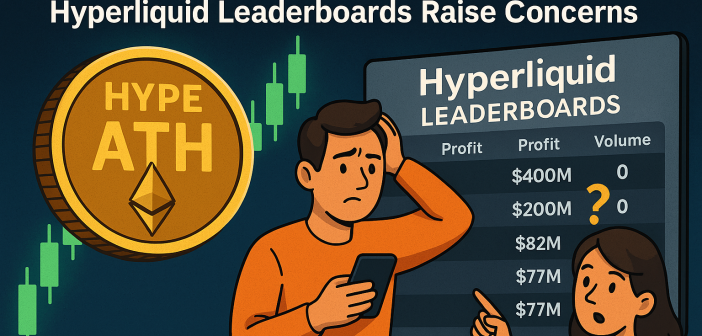The native token of Hyperliquid, HYPE, has hit a fresh all-time high, signaling growing market interest in the decentralized perpetual futures exchange. But while the token soars, crypto investors have started raising concerns about Hyperliquid leaderboards, which appear to misrepresent trader profitability.
This strange discrepancy has triggered debate within the community and cast a shadow over the transparency that Hyperliquid claims to champion.
Hyperliquid Leaderboards: Data Glitch or Design Flaw?
On May 26, crypto trader Smolting flagged an oddity in the Hyperliquid leaderboards: one trader, who reportedly lost millions, appeared among the top profit-makers. According to the stats, this wallet was up $400 million in the past 30 days, yet hadn’t placed a single trade in that timeframe.
Other top entries were similarly suspicious:
-
Second-ranked trader: +$200 million
-
Third: +$82 million
-
Fourth: +$77 million
-
Zero trading volume across all of them
Only from the fifth position onward did the leaderboard include traders with actual transaction history. The inconsistencies have fueled concerns about how PnL dashboards on Hyperliquid calculate performance — and whether they reflect real activity.
This raises serious questions: are these bugs, leftover profits from earlier trades, or an exploitable feature?
Hyperliquid vs Binance: Vaults, Margins, and Transparency
Despite such confusion, Hyperliquid continues to grow. Like Binance, it offers leveraged perpetuals and runs on a custom blockchain. Both use native tokens — HYPE for Hyperliquid, BNB for Binance — that provide users with trading fee discounts.
But Hyperliquid goes a step further. Any user can create an offshore hedge fund, referred to as a vault, directly on the platform — a feature even Binance doesn’t offer. These vaults, combined with real-time PnL visibility, make the platform attractive to high-risk traders and funds.
At the same time, this openness has its downsides:
-
Admins can change margin rules at will — recently, they hiked margin requirements to 20% after a trader deliberately nuked a major position to damage the liquidity pool.
-
Critics accuse Hyperliquid of “pay-to-play” mechanics.
-
The codebase is closed, documentation is sparse, and the API is centralized.
Despite this, HYPE’s bullish momentum reflects growing interest. But whether Hyperliquid leaderboards and internal rules will pass the test of long-term transparency remains to be seen.




